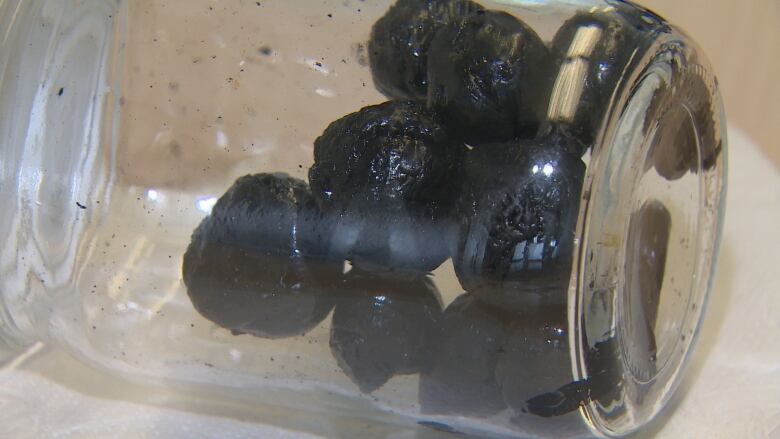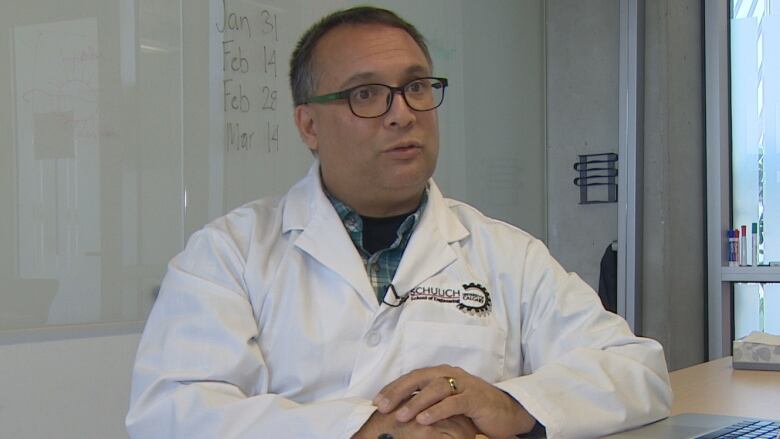Balls of bitumen: Calgary breakthrough could bypass pipeline problem, researcher says
Engineer says his team's spill-resistant pellets of heavy oil can be safely transported by rail

A Calgary engineer thinks an invention he stumbled upon in the laboratory could transform the way Alberta gets its heavy oil to market.
Ian Gates was researching ways to upgrade bitumen when he and his teamaccidentally found a way to degrade it, making it even more viscous which, in turn, led to a discovery that they could envelope the oil in self-sealingpellets, with a liquid core and super-viscous skin.
These tough little balls of bitumen could be a pipeline-free way of getting Alberta oil to markets cheaply, sustainably and with less risk of environmental harm, said a release from theUniversity of Calgary's Schulich School of Engineering, where Gates is a professor.
"We've taken heavy oil, or bitumen, either one, and we've discovered a process to convert them rapidly and reproducibly into pellets," Gates told CBC News.
"With this, we can put it in a standard rail car. It can go to any port where a rail car goes, which is an immense number of them, to get product out from North America."
Gates says the pellets could be put in thethousands ofrail cars built for coal that are now sitting idle.
"Pipelines, they have their role. I don't think it will replace pipelines. This just offers one more mode of transport," Gates told the Calgary Eyeopener.
"But certainly you could see it displacing some of the heated railcars."
Gates and his team of researchers have developed the technology to the point where they can make pellets of various sizes right at the wellhead, using about the same amount of energy as it takes to add diluent to the bitumen to liquefy it for shipping via pipelines.
"Think Advil," Gates said. "You have the chemical material ... we're then exposing that material, on the outside, to a set of heat, pressure conditions, that then yield a asphaltine-rich coating. So, really just a coating that bounds the inner material."

Environmentally safe
The pellets are tough and can be safely transported by rail or truckwithout worrying about spills.
Because of a gas bubble injected inside each pellet, they are also buoyant, Gates says.
"They're nice and hardy. If you put them in water, they'll sit like that for a very long time," Gatessaid.
"It's a safe product for transport."
- MORE SCIENCE NEWS |Why the quest for a recent meteorite won't start with a burning trail through the woods
The research and the effort to translate it into a commercially viable ideawas supported by the U of C's Innovate Calgary, the school's technologyand business-incubation centre.
"We were able [to] connect with potential industry partners and customers who might help advance the technology to a field trial, and ultimately, a full scale solution," said Stace Wills, vice-president of energy at Innovate Calgary.
By November, the fully automated technologywill be producing barrels of the tiny balls, the school says.
Over the next year we'll then scale that up to a several-hundred-barrel per day unit," Gates said.
He says there are several companies interested in moving the newly patented invention forward.
Once the pellets are transported, they can be reconstituted back to bitumen by re-mixing them with a light oil which is produced as a side product of the original process and thenupgraded in the regular way.
"So you'd have to transport the light oil with the solids if you want to reconstitute the heavy oil," Gates said.
Or, the pelletscan be used as they are.
The balls are an ideal feed stock forroad paving, without the need to upgrade the product anyfurther, Gates says.
"In that case, all you do is sell the solid to those markets," he said.
With files from the Calgary Eyeopener
With files from Rebecca Kelly













_(720p).jpg)


 OFFICIAL HD MUSIC VIDEO.jpg)
.jpg)



























































































